|
Location:
Supe Valley, Peru. |
Grid Reference:
10o
53' 39.55" S 77o
31' 20.05" W. |
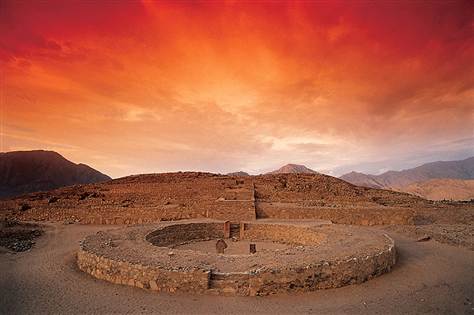
 Caral:
(Pyramid Complex).
Caral:
(Pyramid Complex).
The
Caral-Supe valley was inhabited between roughly 2,600
B.C and 2,000 B.C (1). Caral was described by
its excavators as the oldest urban centre in the
Americas, a claim that has since been challenged by the
discovery of even earlier
ancient sites nearby.
At 2,600 BC,
this is the oldest centre of civilisation in the Americas.
A quipu (the knot system used in Andean civilizations to record
information) found on the site associates the culture with the later
Incas. The city�s plan and some of its
components, including pyramidal structures and residence of the
elite, show clear evidence of ceremonial functions and
monumental architecture, including six large pyramidal
structures. (2)
(Click
Here for Map of Site)
|
Caral: (Caral-Supe, Norte Chico). |
Caral made headlines in 2001 when researchers carbon-dated
material from the city back to 2,627 B.C.
(3) the very time that the Egyptians were
building their first pyramid complexes.
The layout of
the city shows signs of it being planned with districts set
aside for different trades, for the wealthy and the poor. The
163-acre city was the administrative centre for a complex
civilization. The site of Caral and the cluster of 18
similarly dated sites located in the Supe Valley form
what is now called the Caral-Supe Civilization. They are important
because together they represent the earliest known urban
settlements in the Americas, predating the Olmecs by a
solid thousand years.
The Caral-Supe Civilisation is the earliest known in the
Americas.
The centre of
the Caral complex consists of a central public area with six large platform mounds
arranged around a huge plaza. The largest of the mounds is 60
feet high and measures 450 x 500 feet at the base. All of these
mounds were built within one or two building periods, which
suggests a high level of planning, generally associated with
state level societies. The public architecture has stairs,
rooms, and courtyards; and three sunken plazas suggest
society-wide religion. Of the 18 other sites near Caral, ten are
more than 60 acres in size; all of them have similar public
architecture. Crops included squash, beans, and cotton, grown in
the dry desert climate with the assistance of a intricate
irrigation system.

Three of the
Caral Pyramids:
To erect their structures, they perfected the
"shicra-bag" technique, by which armies of workers would gather
a long, durable grass known as shicra in the highlands above the
city, tie the grass strands into loosely meshed bags, fill the
bags with boulders, and then pack the trenches behind each
successive retaining wall of the step pyramids with the
stone-filled bags. With bags acting as landfill, anchoring and
reinforcing the structure at each stage, the people of Caral
were able to build pyramids up to 70 feet tall. It was the
grasses that made these bags which allowed archaeologists to so
accurately radio-carbon date the complex.
The Caral Quipu:
The Inca were
known to have used a complicated system of
knotted cords of different colours called Quipus.
Many of these quipus (also spelled khipus) were
destroyed by the Spanish conquistadors in the
16th century, but approximately 200 of them
dating no earlier than about 650 AD have been
found.
The recovery of
quipu from the civilization of Caral, if the
context and dates are correct, suggests several
things. First, this is additional evidence that
Caral was a likely precursor to the Inca
civilization (since the Incas also used quipu).
Secondly, quipu as a tradition dates at least
2000 years older than we recognized prior to
this point. Thirdly, and most importantly, if
quipu were indeed a form of written
communication, they are among the earliest forms
of writing in the world, only slightly younger
than cuneiform, which has been identified at the
Mesopotamian site of Uruk approximately 3000
years BC.
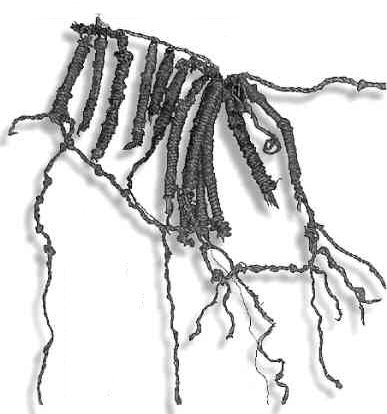
The quipu with its
well-preserved, brown cotton strings wound
around thin sticks, was found with a series of
offerings including mysterious fibre balls of
different sizes wrapped in "nets" and pristine
reed baskets. "We are sure it corresponds to the
period of Caral because it was found in a public
building," Shady said. "It was an offering
placed on a stairway when they decided to bury
this and put down a floor to build another
structure on top."
|
Coca Use
at Caral:
Evidence of drug use and possibly
aphrodisiacs was found at Caral. One theory
suggests that the coca they found may be
evidence that Caral sprung up as an
organized coca growing and distribution
centre.
Excavations convinced Shady
(The primary archaeologist) that
Caral had served as a major trade centre
for the region, ranging from the rain
forests of the Amazon to the high
forests of the Andes. She found
fragments of the fruit of the achiote,
a plant still used today in the rain forest as
an aphrodisiac. And she found necklaces of
snails and the seeds of the coca plant, neither
of which was native to Caral.'
(7)
(More
about Drug Use in Prehistory) |
Bird-bone Flutes:
The discovery of
32 flutes made of Pelican and Condor Bones, echoes the
Palaeolithic Old-world fascination with bird-bone flutes. Several
horns made from Llama or Alpaca bones were also found.
(3)
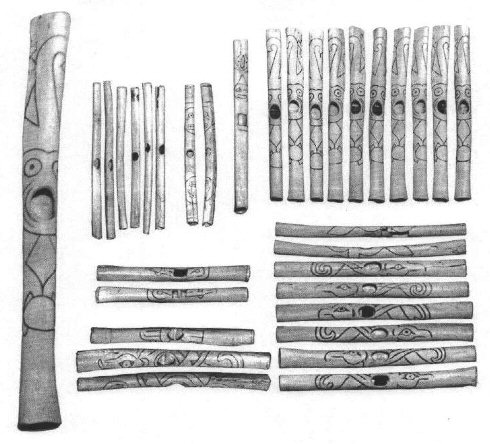
The Flutes were
found between the pyramids within the large sunken amphitheatre,
with enough room for hundreds of people during community
gatherings. The 32 flutes made of the wing bones of pelicans
were tucked into a recess in the main temple. They were played
by blowing into the central hole and covering either the left or
right hand holes. And, in
April 2002, they uncovered 37 cornets of deer and llama bones.
"Clearly, music played an important role in their society,".
Based on the
radiocarbon dating from [Solis 2001], the most likely date for
the flutes appears to be 2170�90 BCE (Sample �Beta 134427 -
Offering inside room on top of Piramide Mayor, Caral�).
(More
about Bird-bone Flutes)
(More
about Archaeo-acoustics)
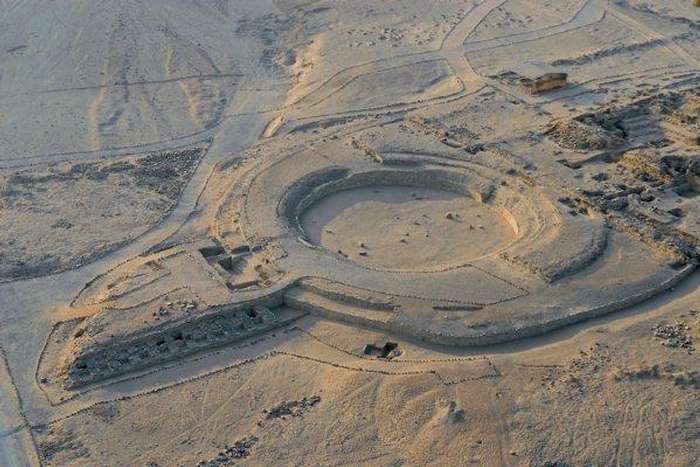
One of the two
sunken amphitheatres at Caral. (Photo Credits UNESCO)
The 'Piramide Mayor'.
The largest platform mound, the
'Piramide Mayor', is
160 x 150 m and 18 m high. It is the largest of six platform
structures in the Caral city, all built of quarried stone and river
cobbles carried and placed in reed bags. The outer walls were
covered with multiple layers of coloured plaster
(5)
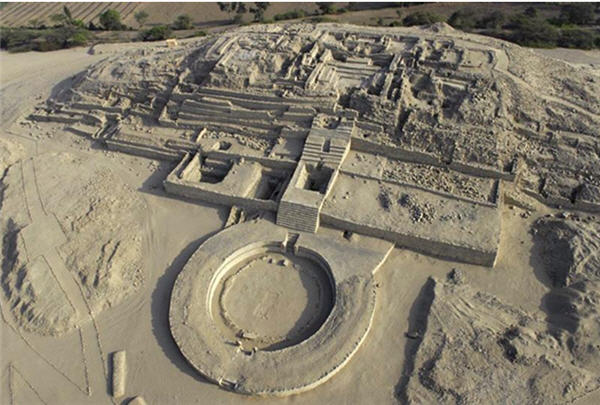
The 'Greater Pyramid',
is a strikingly large building
located in a dominating position within the urban plan of Caral. It
is said that officials standing on the highest part of this pyramid
could monitor not only the activities going on the city, but also a
large part of the capital area in the middle valley. At the site was
found the corpse of a young man who was probably sacrificed in honour
to local gods. Archaeologist also discovered walls decorated with
small figures and collars made of shark teeth. A 29-foot wide
staircase opens into a series of small rooms, which include an
atrium and a sacred altar. The altar room has a small hole in the
floor, in which offerings were once burned.
(Pyramids
Homepage)
The Monolith 'Huanca'.
 Huanca means �standing stone�, and this impressive
monolith stands 2.15 meters in height directly due north of the
Huanca pyramid. It is therefore considered to be related to the
astronomical and ceremonial aspects of life in Caral. Likewise, it
is found across from the main staircase of the important Pyramid of
the Huanca. Archaeologists believe that this monolith was used for
astronomical and ceremonial purposes. Huanca means �standing stone�, and this impressive
monolith stands 2.15 meters in height directly due north of the
Huanca pyramid. It is therefore considered to be related to the
astronomical and ceremonial aspects of life in Caral. Likewise, it
is found across from the main staircase of the important Pyramid of
the Huanca. Archaeologists believe that this monolith was used for
astronomical and ceremonial purposes.
The stone monolith of some 2 meter in height
called "La Huanca" was uncovered and appears to connect with the adjacent Galeria and Huanca Pyramids.
It is said that the angle of the stone to
the tops of the pyramids marks the location of the summer and winter
solstices of about 40+ degrees. (To be confirmed...)
(Peru
homepage)
(Index
of Ancient Sites) |






 Huanca means �standing stone�, and this impressive
monolith stands 2.15 meters in height directly due north of the
Huanca pyramid. It is therefore considered to be related to the
astronomical and ceremonial aspects of life in Caral. Likewise, it
is found across from the main staircase of the important Pyramid of
the Huanca. Archaeologists believe that this monolith was used for
astronomical and ceremonial purposes.
Huanca means �standing stone�, and this impressive
monolith stands 2.15 meters in height directly due north of the
Huanca pyramid. It is therefore considered to be related to the
astronomical and ceremonial aspects of life in Caral. Likewise, it
is found across from the main staircase of the important Pyramid of
the Huanca. Archaeologists believe that this monolith was used for
astronomical and ceremonial purposes.